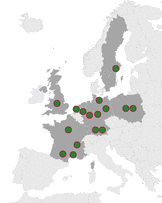WP04 - Data management and statistical analysis
Objectives
WP4 will ensure proper data management of all data acquired in the outcome study and perform statistical analysis to answer the research questions of the study.
- To assure the appropriate methodology for answering the research questions (Task 1)
- To manage data, which contains designing and creating the database, data entry, processing data (Task 2)
- To manage statistical analysis of therapeutic interventions and outcome measures (Task 3)
- To identify and control influencing factors of outcome measures (Task 4)
Work Package Description
Proper data management and statistical analysis is a prerequisite for correct and successful conduction of the study. WP4 ensures appropriate methodology during preparation and conduction of the study. It contains designing and creating the database, data entry, processing and controlling data and statistical data analysis throughout the evaluation phase. The outcomes of the various treatment/intervention regimens for DSD will be analysed and influencing factors will be identified within and after the evaluation phase. WP4 will be lead by the Coordinating Centre of Clinical Trials (CHARITE), which has a long standing experience in statistics of large clinical studies.
Task 1: Finalisation of methodological and statistical aspects of the study protocol
Final decision will be made on the study design and statistical tests to be applied. Methodological aspects of the clinical study protocol will be reviewed and finalised.
Task 2: Data management
A dsd-LIFE database will be designed and created throughout the project year 1. Due to data safety reasons and to comply with the data privacy protection, the personal data of every patient will be pseudonymized. This ensures the strictly split between the personal data and patient-related dataset (trial data).The Remote Data Entry (RDE) system generates automatically a pseudonym for every new patient. The pseudonym will be a combination of six alphanumeric characters. All trial data of the patient will be linked with this pseudonym. Personal data of the patient will not be saved in the trial database at any time. Data required for the analysis will be acquired and transferred electronically to a central database at the Coordinating Centre of Clinical Trials at Charité using an Electronic Data Capture system (EDC). This system allows the documentation of study data on electronic case report form (eCRF). Study data will be entered online direct by the sites. The access to the eCRF requires the authentication by the study participants. All access rights (read or enter data) will be defined depending on their function in the study (Principle, clinical investigator, CRA, etc.). At the end of the study the data will be exported from the database.The study data will be prepared for the statistical analysis. This data management process contains the plausibility, consistency, identification of missing data and range checks of the data. Information of missing data will be given to the respective study centre for possible completion or explanation of missing data.
Task 3: Statistical analysis of outcome measures according to treatment
Statistical analysis of outcome measures, in dependence of scale level and distribution, according the post-hoc power-calculation will be performed from month 29 to month 40. The statistical power of comparisons between patient groups depends on whether large samples (400, 200, 100 subjects) or subgroups of smaller size (expected are subgroups with at least 50 subjects) are evaluated. With 400, 200, 100 subjects, differences in proportions of about 15%, 20%, 29% respectively can be detected with power of 80%, level of significance 5%. With 50 subjects, differences of about 29% can be detected. Each test for proportions will proved by a post-hoc power analyses. In addition an alpha-adjustment for the entirety of all tests is planned. Also 95% confidence intervals will be calculated. Descriptives for all primary and secondary clinical, demographic and safety parameters will include absolute and relative frequencies for categorial variables and mean, standard deviation, median, and range for quantitative measurements, according the statistical analysis plan (SAP).
Additional subgroup analyses are planned. Controlling for potential confounders will performed by using multiple statistical models adjusting for these variables. The power-calculations and statistical analysis will be performed by nQuery Advisor and SAS v9.3. (see WP3).
Task 4: Identification of influencing factors and confounders
95% confidence intervals will be calculated. Descriptives for all primary and secondary clinical, demographic and safety parameters will include absolute and relative frequencies for categorial variables and mean, standard deviation, median, and range for quantitative measurements, according the statistical analysis plan (SAP). Additional subgroup analyses are planned. Controlling for potential confounders will performed by using multiple statistical models adjusting for these variables.


